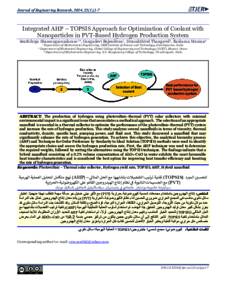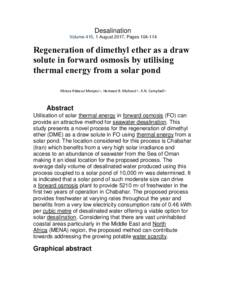Document
Integrated AHP–TOPSIS approach for optimization of coolant with nanoparticles in PVT-based hydrogen production system.
Identifier
DOI.org/10.53540/tjer.vol21iss1pp1-7
Source
Journal of Engineering Research, v. 21, no. 1, p. 1-7.
Contributors
Other titles
نهج متكامل لتحليل العملية الهرمية (AHP) وتقنية ترتيب التفضيلات بتشابهها مع الحل المثالي (TOPSIS) لتحسين السوائل المبردة بالجسيمات النانوية في نظام إنتاج الهيدروجين القائم على المجمعات الشمسية الكهروضوئية–الحرارية (PVT).
Country
Oman
City
Muscat
Publisher
College of Engineering, Sultan Qaboos University.
Gregorian
2024-04-29
Language
English
Subject
English abstract
The production of hydrogen using photovoltaic–thermal (PVT) solar collectors with minimal environmental impact is a significant issue that necessitates a methodical approach. The selection of an appropriate nanofluid is essential in a thermal collector to optimize the performance of the photovoltaic–thermal (PVT) system and increase the rate of hydrogen production. This study analyzes several nanofluids in terms of viscosity, thermal conductivity, density, specific heat, pumping power, and fluid cost. This study discovered a nanofluid that may significantly enhance the rate of hydrogen generation. To achieve this objective, the analytical hierarchy process (AHP) and Technique for Order Preference by Similarity to Ideal Solution (TOPSIS) methods were used to identify the appropriate choice and assess the hydrogen production rate. The findings indicate that a hybrid nanofluid consisting of a 0.2% volume concentration of Al2O3–CuO in water exhibits the most favourable heat transfer characteristics and is considered the best option for improving heat transfer efficiency and boosting the rate of hydrogen generation.
ISSN
Online: 1726-6742
Print: 1726-6009
Arabic abstract
إنتاج الهيدروجين باستخدام مجمعات شمسية كهروضوئية–حرارية مع تأثير بيئي ضئيل هو مسألة مهمة تتطلب نهجًا منهجيًا. اختيار سائل نانوي مناسب في المجمع الحراري ضروري لتحسين أداء النظام الكهروضوئي–الحراري وزيادة معدل إنتاج الهيدروجين. تحلل هذه الدراسة عدة سوائل نانوية من حيث اللزوجة، التوصيل الحراري، الكثافة، الحرارة النوعية، قوة الضخ، وتكلفة السائل. وقد اكتشفت هذه الدراسة سائلًا نانويًا قد يعزز بشكل كبير معدل إنتاج الهيدروجين. لتحقيق هذا الهدف، تم استخدام أسلوب العملية التحليلية الهرمية (AHP) وتقنية ترتيب التفضيلات بتشابهها مع الحل المثالي (TOPSIS) لتحديد الخيار المناسب وتقييم معدل إنتاج الهيدروجين. تشير النتائج إلى أن سائل نانوي هجين يتكون من تركيز حجمي بنسبة 0.2% من Al2O3–CuO في الماء يتمتع بخصائص نقل حراري مواتية للغاية ويعتبر الخيار الأفضل لتحسين كفاءة نقل الحرارة وزيادة معدل إنتاج الهيدروجين.
Category
Journal articles


